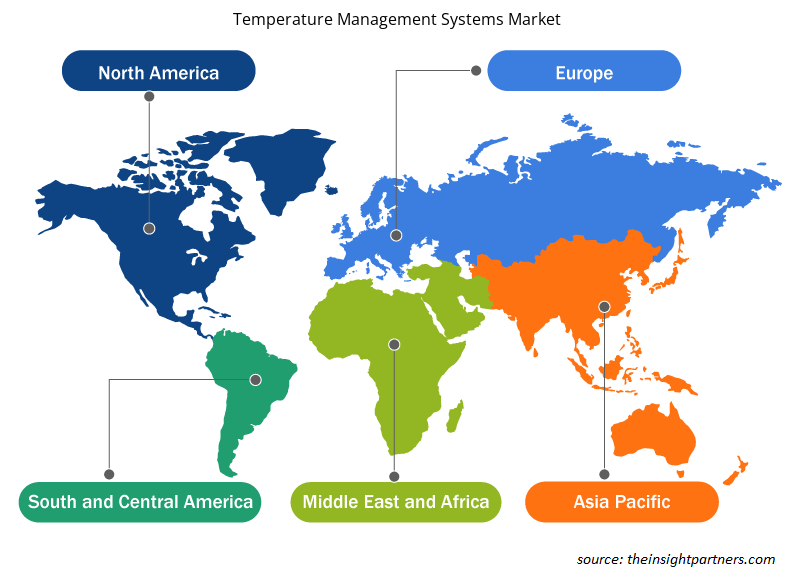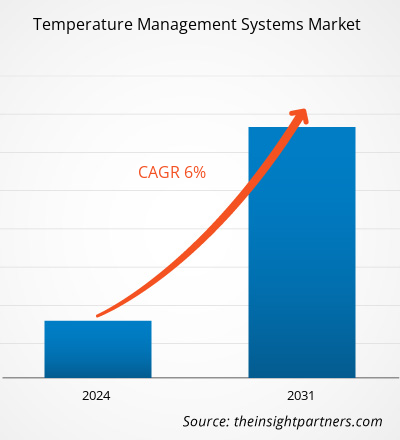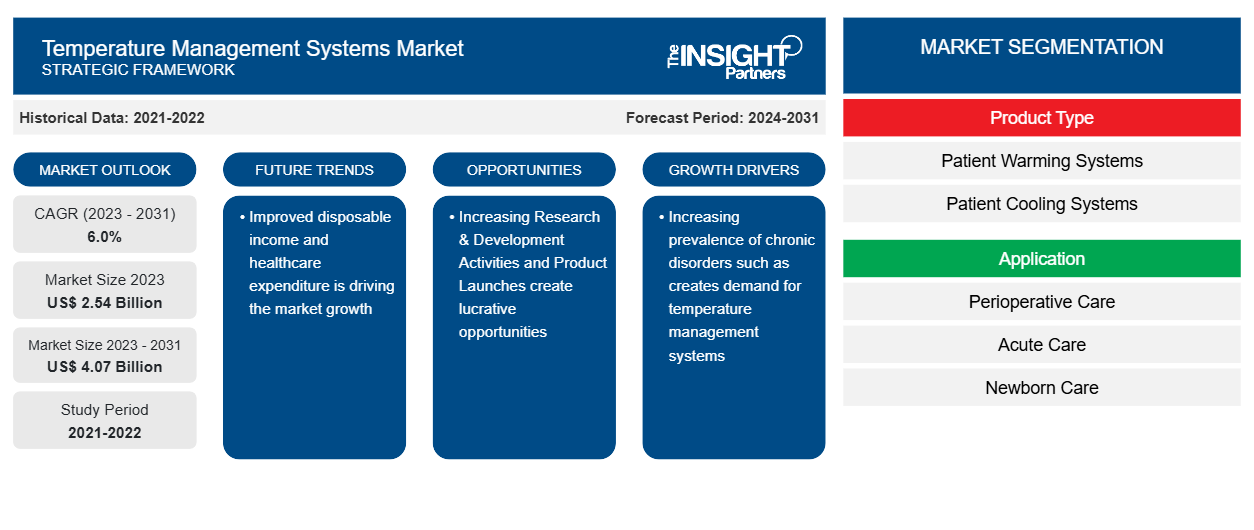Das Marktvolumen für Temperaturmanagementsysteme soll von 2,54 Milliarden US-Dollar im Jahr 2023 auf 4,07 Milliarden US-Dollar im Jahr 2031 anwachsen. Für den Zeitraum 2023–2031 wird eine durchschnittliche jährliche Wachstumsrate (CAGR) von 6,0 % erwartet. Die zunehmende Tendenz zu tragbaren Temperaturüberwachungs- und Therapiegeräten dürften weiterhin die wichtigsten Trends auf dem Markt bleiben.
Marktanalyse für Temperaturmanagementsysteme
Die zunehmende Verbreitung chronischer Erkrankungen wie Schlaganfall, Herz-Kreislauf-Erkrankungen, Onkologie und anderer Erkrankungen sowie die Zunahme chirurgischer Eingriffe dürften das Marktwachstum vorantreiben. Darüber hinaus führt eine Zunahme der Forschungs- und Entwicklungsaktivitäten zu Innovationen und die Markteinführung neuer Produkte, gefolgt von strategischen Initiativen zur geografischen Expansion, dürfte reichlich Möglichkeiten für das Marktwachstum schaffen. Die wichtigsten Trends des Marktes sind jedoch die zunehmende Neigung zu tragbaren Temperaturüberwachungsgeräten und therapeutischen Geräten.
Marktübersicht für Temperaturmanagementsysteme
Die zunehmende Verbreitung chronischer Erkrankungen wie Schlaganfall, Herz-Kreislauf-Erkrankungen, Onkologie und anderer Erkrankungen sowie die Zunahme chirurgischer Eingriffe werden voraussichtlich das Marktwachstum vorantreiben. Nordamerika dominierte das Marktwachstum aufgrund der zunehmenden Innovationen bei Temperaturmanagementsystemen und der zunehmenden Zahl von Erkrankungen des zentralen Nervensystems. Dies sind einige der Faktoren, die das Wachstum des nordamerikanischen Marktes für Temperaturmanagementsysteme beschleunigen dürften. Darüber hinaus werden zunehmende F&E-Aktivitäten und die Einführung neuer Produkte wahrscheinlich weitere Marktchancen schaffen. Der asiatisch-pazifische Raum dürfte jedoch aufgrund der wachsenden Technologie, der wachsenden geriatrischen Bevölkerung und der zunehmenden Verbreitung von Herz-Kreislauf-Erkrankungen die deutlichste Wachstumsrate verzeichnen. China hat aufgrund der höheren Prävalenz orthopädischer und Herzerkrankungen, die eine stationäre Behandlung erfordern, und der zunehmenden Forschungsaktivitäten den größten Marktanteil, und Indien dürfte im Prognosezeitraum das deutlichste Wachstum verzeichnen.
Passen Sie diesen Bericht Ihren Anforderungen an
Sie erhalten kostenlos individuelle Anpassungen an jedem Bericht, einschließlich Teilen dieses Berichts oder einer Analyse auf Länderebene, eines Excel-Datenpakets sowie tolle Angebote und Rabatte für Start-ups und Universitäten.
-
Holen Sie sich die wichtigsten Markttrends aus diesem Bericht.Dieses KOSTENLOSE Beispiel umfasst eine Datenanalyse von Markttrends bis hin zu Schätzungen und Prognosen.
Markttreiber und Chancen für Temperaturmanagementsysteme
Steigende Zahl chirurgischer Eingriffe begünstigt den Markt
Die Körpertemperatur ist einer der lebenswichtigen Parameter des menschlichen Körpers während Operationen. Wenn die Körpertemperatur unbeabsichtigt unter 36°C (96,8°F) fällt, sprechen Ärzte von perioperativer Hypothermie. Wird dieser Zustand nicht früh genug erkannt, kann die niedrige Temperatur zu medizinischen Komplikationen führen. Perioperative Hypothermie tritt bei fast allen Operationen auf. Ein Temperaturmanagementsystem dient der Hypothermieprävention und vereinfacht die Anästhesie von Patienten während Operationen durch eine schnelle und effektive Wärmezufuhr.perioperative hypothermia. If this condition is not noticed early enough, the low temperature can lead to medical complications. Perioperative hypothermia occurs almost during all surgeries. A temperature management system serves as hypothermia prevention and simplifies the anesthesia of patients during surgeries due to a fast and effective heat supply.
Die wachsende geriatrische Bevölkerung, die zunehmende Verbreitung chronischer Krankheiten, die Zunahme der Unfallzahlen und die Zunahme der Krankenhauseinweisungen haben zu einer Zunahme der Anzahl chirurgischer Eingriffe geführt. Dank des technologischen Fortschritts führen verschiedene Krankenhäuser und medizinische Institute jährlich eine große Anzahl chirurgischer Eingriffe durch. So werden beispielsweise weltweit jährlich durchschnittlich 313 Millionen chirurgische Eingriffe durchgeführt.
Steigende Forschungs- und Entwicklungsaktivitäten sowie Produkteinführungen schaffen lukrative Möglichkeiten
Branchenakteure führen eine Vielzahl von Forschungs- und Entwicklungsaktivitäten durch, um fortschrittliche Temperaturüberwachungssysteme zu entwickeln. Diese Technologiepartnerschaften werden im Prognosezeitraum voraussichtlich erhebliche Möglichkeiten für die Markteinführung neuer Produkte und die Einführung einer Vielzahl von Produkten bieten. So brachte Microchip Technology im Januar 2024 die MCP998x-Familie mit 10 für die Automobilindustrie qualifizierten Ferntemperatursensoren auf den Markt. Diese neue Familie von Ferntemperatursensoren erweitert die Kundenauswahl in einer Produktkategorie, die in der Vergangenheit nur begrenzte Optionen bot. Darüber hinaus unterzeichneten ZOLL und Global Healthcare SG im Juni 2021 eine exklusive Vereinbarung zum Vertrieb eines tragbaren, gezielten Temperaturmanagementsystems im asiatisch-pazifischen Raum. Darüber hinaus führt die Konsolidierung von Forschungs- und Entwicklungsaktivitäten zu Produktinnovationen, die voraussichtlich erhebliche Möglichkeiten für die Produktakzeptanz bieten. Ebenso kann ein starker Fokus auf Forschungsaktivitäten im Prognosezeitraum erweiterte Wachstumschancen für den Markt für Temperaturmanagementsysteme bieten.ZOLL and Global Healthcare SG signed an exclusive agreement to distribute a portable targeted temperature management system in Asia Pacific. Further, consolidation of research and development activities leads to product innovations that are likely to offer significant opportunities for product adoption. Likewise, a robust focus on research activities can offer expanded growth opportunity for the temperature management systems market during the forecast period.
Marktbericht zu Temperaturmanagementsystemen – Segmentierungsanalyse
Wichtige Segmente, die zur Ableitung der Marktanalyse für Temperaturmanagementsysteme beigetragen haben, sind Produkt, Anwendung und medizinische Indikation.
- Basierend auf dem Produkttyp ist der Markt für Temperaturmanagementsysteme in Patientenwärmsysteme und Patientenkühlsysteme unterteilt. Das Segment Patientenwärmsysteme hatte im Jahr 2023 einen größeren Marktanteil.
- Nach Anwendung ist der Markt in perioperative Versorgung, Akutversorgung, Neugeborenenversorgung und andere unterteilt. Das Segment der perioperativen Versorgung hatte im Jahr 2023 den größten Marktanteil.
- In Bezug auf die medizinische Indikation wird der Markt in Allgemeinchirurgie, Kardiologie, Neurologie, Pädiatrie, orthopädische Chirurgie, Thoraxchirurgie und Sonstiges unterteilt. Das Segment Allgemeinchirurgie hatte im Jahr 2023 einen erheblichen Marktanteil.
Temperaturmanagementsysteme Marktanteilsanalyse nach Geografie
Der geografische Umfang des Marktberichts zu Temperaturmanagementsystemen ist hauptsächlich in fünf Regionen unterteilt: Nordamerika, Asien-Pazifik, Europa, Naher Osten und Afrika sowie Süd- und Mittelamerika.
Nordamerika dominiert den Markt aufgrund der zunehmenden Innovationen bei Temperaturmanagementsystemen und der zunehmenden Zahl von Erkrankungen des zentralen Nervensystems. Diese Faktoren dürften das Wachstum des nordamerikanischen Marktes für Temperaturmanagementsysteme beschleunigen. Darüber hinaus dürften zunehmende F&E-Aktivitäten und die Einführung neuer Produkte dem Markt weitere Chancen eröffnen. Die USA halten den größten Marktanteil aufgrund der zunehmenden Verbreitung chronischer und kardialer Erkrankungen, der steigenden Zahl von Produkteinführungen durch wichtige Akteure und der zunehmenden Konzentration auf vorbeugende Maßnahmen zur Bekämpfung der Krankheitsprävalenz und Patientenüberwachung. Der asiatisch-pazifische Raum wird in den kommenden Jahren voraussichtlich die höchste durchschnittliche jährliche Wachstumsrate aufweisen.
Regionale Einblicke in den Markt für Temperaturmanagementsysteme
Die regionalen Trends und Faktoren, die den Markt für Temperaturmanagementsysteme während des Prognosezeitraums beeinflussen, wurden von den Analysten von Insight Partners ausführlich erläutert. In diesem Abschnitt werden auch die Marktsegmente und die Geografie von Temperaturmanagementsystemen in Nordamerika, Europa, im asiatisch-pazifischen Raum, im Nahen Osten und Afrika sowie in Süd- und Mittelamerika erörtert.

- Erhalten Sie regionale Daten zum Markt für Temperaturmanagementsysteme
Umfang des Marktberichts zu Temperaturmanagementsystemen
| Berichtsattribut | Details |
|---|---|
| Marktgröße im Jahr 2023 | 2,54 Milliarden US-Dollar |
| Marktgröße bis 2031 | 4,07 Milliarden US-Dollar |
| Globale CAGR (2023 - 2031) | 6,0 % |
| Historische Daten | 2021-2022 |
| Prognosezeitraum | 2024–2031 |
| Abgedeckte Segmente |
Nach Produkttyp
|
| Abgedeckte Regionen und Länder |
Nordamerika
|
| Marktführer und wichtige Unternehmensprofile |
|
Marktteilnehmerdichte: Der Einfluss auf die Geschäftsdynamik
Der Markt für Temperaturmanagementsysteme wächst rasant, angetrieben durch die steigende Nachfrage der Endnutzer aufgrund von Faktoren wie sich entwickelnden Verbraucherpräferenzen, technologischen Fortschritten und einem größeren Bewusstsein für die Vorteile des Produkts. Mit steigender Nachfrage erweitern Unternehmen ihr Angebot, entwickeln Innovationen, um die Bedürfnisse der Verbraucher zu erfüllen, und nutzen neue Trends, was das Marktwachstum weiter ankurbelt.
Die Marktteilnehmerdichte bezieht sich auf die Verteilung der Firmen oder Unternehmen, die in einem bestimmten Markt oder einer bestimmten Branche tätig sind. Sie gibt an, wie viele Wettbewerber (Marktteilnehmer) in einem bestimmten Marktraum im Verhältnis zu seiner Größe oder seinem gesamten Marktwert präsent sind.
Die wichtigsten auf dem Markt für Temperaturmanagementsysteme tätigen Unternehmen sind:
- 3M
- ZOLL MEDICAL CORPORATION
- BD
- Smiths Medical
- Drägerwerk AG & Co. KGaA
- Ecolab
Haftungsausschluss : Die oben aufgeführten Unternehmen sind nicht in einer bestimmten Reihenfolge aufgeführt.

- Überblick über die wichtigsten Akteure auf dem Markt für Temperaturmanagementsysteme
Marktnachrichten und aktuelle Entwicklungen zum Temperaturmanagementsystem
Der Markt für Temperaturmanagementsysteme wird durch die Erhebung qualitativer und quantitativer Daten nach Primär- und Sekundärforschung bewertet, die wichtige Unternehmensveröffentlichungen, Verbandsdaten und Datenbanken umfasst. Nachfolgend sind einige der Entwicklungen auf dem Markt für Temperaturmanagementsysteme aufgeführt:
- SourceMark arbeitete mit Gentherm Medical bei der Versorgung bestimmter Gentherm-Produktlinien zur Patientenerwärmung in den Vereinigten Staaten zusammen, darunter Astopad, ein resistives Wärmesystem zur Vorbeugung und Behandlung von Hypothermie, Norm-O-Temp, ein Ganzkörper-Hyperthermiesystem, Gelli-Roll, ein wiederverwendbares Wärme- und Kühlgelkissen, das konvektive Patientenerwärmungssystem WarmAir und FilteredFlo-Luftwärmdecken für Patienten. (Quelle: SourceMark Medical, Pressemitteilung, Januar 2024)
- Watlow hat die neuen Hochtemperatur-Heizmäntel ASSURANT HT auf den Markt gebracht, die speziell auf die besonderen Anforderungen der Halbleiterverarbeitung zugeschnitten sind. Diese Lösungen bieten eine gleichmäßige Erwärmung für einheitliche Temperaturprofile über die gesamte beheizte Linie. Die ASSURANT-Heizmäntel optimieren die Betriebszeit der Prozesswerkzeuge und die Chipausbeute, indem sie die Linie vollständig abdecken und kalte Stellen vermeiden, die zu Partikelablagerungen führen. (Quelle: Watlow Electric Manufacturing Company, Unternehmenswebsite, Oktober 2023)
- ZOLL hat mit BrainCool für den exklusiven Vertrieb des BrainCool-Systems/IQool-Systems und der IQool-System-Pads in den USA und wichtigen Märkten in Europa zusammengearbeitet und arbeitet daran, den Vertrieb auf ausgewählte Märkte in Asien auszuweiten. (Quelle: ZOLL Medical Corporation, Unternehmenswebsite, Juli 2023)
Marktbericht zu Temperaturmanagementsystemen – Umfang und Ergebnisse
Der Bericht „Marktgröße und Prognose für Temperaturmanagementsysteme (2021–2031)“ bietet eine detaillierte Analyse des Marktes, die die folgenden Bereiche abdeckt:
- Marktgröße und Prognose für Temperaturmanagementsysteme auf globaler, regionaler und Länderebene für alle wichtigen Marktsegmente, die im Rahmen des Berichts abgedeckt sind
- Markttrends für Temperaturmanagementsysteme sowie Marktdynamik wie Treiber, Einschränkungen und wichtige Chancen
- Detaillierte PEST/Porters Five Forces- und SWOT-Analyse
- Marktanalyse für Temperaturmanagementsysteme mit Blick auf wichtige Markttrends, globale und regionale Rahmenbedingungen, wichtige Akteure, Vorschriften und aktuelle Marktentwicklungen
- Branchenlandschaft und Wettbewerbsanalyse, die die Marktkonzentration, Heatmap-Analyse, prominente Akteure und aktuelle Entwicklungen für den Markt für Temperaturmanagementsysteme umfasst
- Detaillierte Firmenprofile
- Historische Analyse (2 Jahre), Basisjahr, Prognose (7 Jahre) mit CAGR
- PEST- und SWOT-Analyse
- Marktgröße Wert/Volumen – Global, Regional, Land
- Branchen- und Wettbewerbslandschaft
- Excel-Datensatz
Aktuelle Berichte
Verwandte Berichte
Erfahrungsberichte
Grund zum Kauf
- Fundierte Entscheidungsfindung
- Marktdynamik verstehen
- Wettbewerbsanalyse
- Kundeneinblicke
- Marktprognosen
- Risikominimierung
- Strategische Planung
- Investitionsbegründung
- Identifizierung neuer Märkte
- Verbesserung von Marketingstrategien
- Steigerung der Betriebseffizienz
- Anpassung an regulatorische Trends























 Kostenlose Probe anfordern für - Markt für Temperaturmanagementsysteme
Kostenlose Probe anfordern für - Markt für Temperaturmanagementsysteme